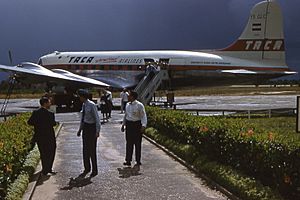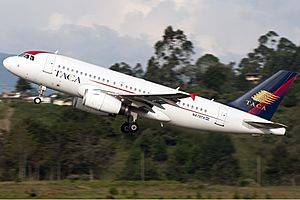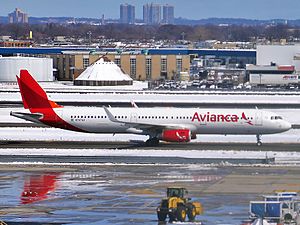Avianca El Salvador facts for kids
 |
|
| Founded | 1931 (as TACA) |
|---|---|
| Hubs | San Salvador |
| Focus cities | San José de Costa Rica–Juan Santamaría |
| Frequent-flyer program | LifeMiles |
| Alliance | Star Alliance (affiliate) |
| Fleet size | 4 |
| Destinations | 24 |
| Parent company | Avianca Group |
| Headquarters | San Salvador, El Salvador |
| Key people | |
Avianca El Salvador is an airline from El Salvador. It is owned by Kingsland Holdings. This airline used to be known as TACA International.
TACA is still the official airline, or flag carrier, of El Salvador. Avianca El Salvador is part of the Avianca Group. This group includes seven airlines in Latin America. The airline has been flying for over 75 years.
TACA once owned and ran five other airlines in Central America. Its first name, TACA, meant Central American Air Transport. Later, it changed to Air Transport of the American Continent. This showed that the airline was growing. It started flying to North, Central, and South America, and the Caribbean.
On October 7, 2009, TACA announced it would join with Avianca. TACA kept its name until the merger was finished on May 21, 2013. TACA was the second oldest airline brand in Central America and the Caribbean. Only Cubana de Aviación was older.
Contents
History
Starting Out (1931–1980)
TACA started in 1931 in Honduras. It was founded by Lowell Yerex from New Zealand. TACA began with one Stinson plane. Its first flights covered all of Honduras.
Yerex wanted to create an airline in each Latin American country. Many TACA airlines were started, but only TACA International of El Salvador continued to fly.
In 1945, Yerex left the company. TACA moved its main office to El Salvador. The airline grew and became more modern. TACA International became an international company. Its main office was only in San Salvador.

In the 1940s and 1950s, TACA started using bigger planes. These included the Douglas DC-3 and Douglas DC-4. Later, they added the Vickers Viscount turboprop plane. This helped them fly to more places in the Americas.
On December 28, 1966, TACA International began using jet planes. Their first jet was a BAC One Eleven. This plane was popular with other airlines. TACA used it until 1988. Then, they started using the Boeing 737-200. From 1976, TACA Air Cargo used the Lockheed L-188 Electra for cargo flights. These flights included trips to Miami, Florida.
Growing Bigger (1980–2009)
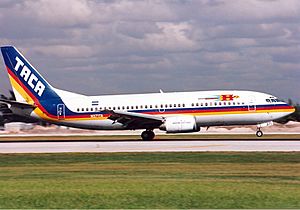
Until 1980, a U.S. company owned TACA. Its main office was in New Orleans. This was because of the civil war in El Salvador. The Kriete Family from El Salvador owned a small part of the company. They later bought all the shares.
By July 1983, TACA flew jet planes to four U.S. cities. These were Houston, Los Angeles, Miami, and New Orleans. TACA also updated its planes in the 1980s. They replaced older planes with more efficient ones. These included the Boeing 737-200 Advanced and 737-300. TACA also used large Boeing 767 planes for international flights. These flew to Los Angeles and Miami.
Between 1990 and 1995, TACA bought most shares of other airlines. These included Aviateca, LACSA, and Nicaragüense de Aviación. They combined their operations under a new name, Grupo TACA.
In the 1990s, TACA International was the first in Latin America to use the Airbus A320. These planes replaced older Boeing 737 planes. The older planes were slowly retired by 1999.
In 1992, TACA partnered with Copa Airlines from Panama. TACA started flying to Tocumen International Airport. This airport became a major flight connection center in Latin America. Many other Latin American airlines joined this partnership. The partnership ended in 1998.
In 2001, TACA set up a base in Lima, Peru. This was its first base in South America. This led to the creation of TACA Perú. TACA owned 49% of this airline. With this, Grupo TACA offered many routes across the Americas.
In 2005, TACA International helped start the Mexican airline Volaris. In the same year, TACA was the first Latin American airline to use the Airbus A321.
In 2008, the company decided to go back to its original name, TACA International. Its main office returned to San Salvador, El Salvador. They also updated their company look. That same year, TACA became the second airline in Latin America to use the Brazilian Embraer 190.
Joining Avianca and Modernizing (2009–2012)
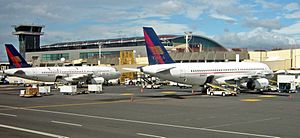
On October 7, 2009, TACA International announced it would join with Avianca. Avianca is the main airline of Colombia. Both airlines kept their own names and operations at first. Together, Avianca and TACA International had 129 planes. They flew to over 100 places in America and Europe. In December 2009, the merger was approved. This merger showed that airlines in Latin America were joining together more often.
In June 2011, AviancaTaca ordered 51 A320 family planes. This included 33 fuel-efficient Airbus A320neos. This was the biggest order for the A320neo in Latin America.
Star Alliance (2010–2012)
On November 10, 2010, Star Alliance announced something important. Avianca and TACA International would become full members. This happened in mid-2012. Star Alliance is a big group of airlines that work together.
Merger Completed and Last Flight
Avianca and TACA finished their merger on May 21, 2013. Just before midnight on May 20, 2013, TACA International started removing its logos. These were taken down from airports in many countries. However, many former TACA planes still had the TACA logo. These planes were later painted with the Avianca logo.
The very last flight using the TACA callsign was TACA Flight 566. It flew from San Salvador to New York City. It left San Salvador at 7:50 pm and landed in New York at 2:35 am. The flight landed after the airlines officially changed names. So, it left as TACA and landed as Avianca. The last official TACA flight with the TACA callsign was TACA Flight 520. It flew from San Salvador to Los Angeles.
The first flight operated by Avianca El Salvador was Flight 561. It flew from San Francisco to San Salvador. It left at 1:25 am and landed at 7:55 am.
Changes in Costa Rica (2012–2013)
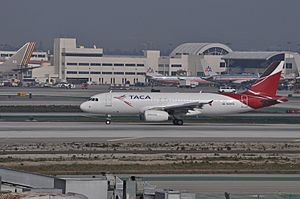
On October 10, 2012, it was announced that the TACA International name would no longer be used for marketing. Avianca would handle all promotions. The CEO of Avianca-Taca said the single brand would be used by mid-2013. Even though the TACA name disappeared, the airline still operates. It now flies under the Avianca El Salvador brand. It is still a full member of Star Alliance. Avianca El Salvador still uses the "TA" and "TAI" codes and the "TACA" call sign for its flights.
On May 18, 2013, the Avianca-Taca group made changes to its hub in Juan Santamaría International Airport in San José, Costa Rica. It became a smaller base of operations. This meant stopping more than five non-stop flights from San Jose. Flights to all cities in the United States were also stopped. Because of this, over 200 employees lost their jobs. This caused some concern in Costa Rica. The country's aviation authorities started an investigation into the company.
Services
The airlines that were once part of Grupo TACA included:
- TACA International
- TACA Regional
- Aviateca
- Inter Regional
- Isleña Airlines
- LACSA
- Nicaragüense de Aviación
- TACA Perú
Before the Avianca merger, TACA's main hubs were:
- Monseñor Óscar Arnulfo Romero International Airport in San Salvador, El Salvador
- Jorge Chávez International Airport in Lima, Peru
- Juan Santamaría International Airport in San José, Costa Rica (this ended in May 2013)
Destinations
Avianca El Salvador flies to 24 places. These destinations are in North, Latin, and South America.
| Country | City | Airport | Notes | Refs |
|---|---|---|---|---|
| Belize City | Philip S. W. Goldson International Airport | Terminated | ||
| Toronto | Toronto Pearson International Airport | |||
| Bogotá | El Dorado International Airport | |||
| Cali | Alfonso Bonilla Aragón International Airport | Terminated | ||
| Cartagena | Rafael Núñez International Airport | Terminated | ||
| Medellín | José María Córdova International Airport | |||
| Liberia | Daniel Oduber Quirós International Airport | Terminated | ||
| San José | Juan Santamaría International Airport | Focus city | ||
| Havana | José Martí International Airport | Terminated | ||
| Guayaquil | José Joaquín de Olmedo International Airport | |||
| Quito | Mariscal Sucre International Airport | |||
| San Salvador | El Salvador International Airport | Hub | ||
| Guatemala City | La Aurora International Airport | |||
| Comayagua | Palmerola International Airport | |||
| Roatán | Juan Manuel Gálvez International Airport | |||
| San Pedro Sula | Ramón Villeda Morales International Airport | |||
| Tegucigalpa | Toncontín International Airport | Terminated | ||
| Cancún | Cancún International Airport | |||
| Mexico City | Mexico City International Airport | |||
| Managua | Augusto C. Sandino International Airport | |||
| Panama City | Tocumen International Airport | |||
| Lima | Jorge Chávez International Airport | |||
| Madrid | Madrid–Barajas Airport | Seasonal | ||
| Boston | Logan International Airport | |||
| Chicago | O'Hare International Airport | Terminated | ||
| Dallas | Dallas/Fort Worth International Airport | |||
| Houston | George Bush Intercontinental Airport | |||
| Las Vegas | Harry Reid International Airport | Seasonal | ||
| Los Angeles | Los Angeles International Airport | |||
| Miami | Miami International Airport | |||
| Newark | Newark Liberty International Airport | Terminated | ||
| New Orleans | New Orleans International Airport | Terminated | ||
| New York City | John F. Kennedy International Airport | |||
| Oakland | Oakland International Airport | Terminated | ||
| Ontario | Ontario International Airport | |||
| Orlando | Orlando International Airport | |||
| San Francisco | San Francisco International Airport | |||
| Washington, D.C. | Dulles International Airport |
Avianca El Salvador shares flights with these airlines:
- Avianca
- Cubana de Aviacion
- Iberia
- United Airlines
Fleet
A fleet is the group of planes an airline uses.
Current fleet
As of June 2023, Avianca El Salvador uses these planes:
| Aircraft | In service |
Orders | Passengers | Notes | |||
|---|---|---|---|---|---|---|---|
| W | Y+ | Y | Total | ||||
| Airbus A320-200 | 1 | — | 12 | 60 | 108 | 180 | |
| Airbus A320neo | 3 | — | |||||
| Total | 4 | — | |||||
Former fleet
TACA International used to fly these planes:
| Aircraft | Total | Introduced | Retired | Notes |
|---|---|---|---|---|
| Airbus A300B4-200F | 5 | 1998 | 2001 | Operated by JHM Airlines Cargo |
| Airbus A319-100 | 14 | 1999 | 2023 | |
| Airbus A321-200 | 6 | 2005 | 2022 | |
| BAC One-Eleven Series 400 | 3 | 1966 | 1988 | |
| BAC One-Eleven Series 500 | 1 | 1981 | 1982 | |
| Beechcraft 17 | 1 | 1950 | 1953 | |
| Bellanca CH-300 Pacemaker | 1 | 1935 | 1944 | |
| Bellanca CH-400 Skyrocket | 3 | 1934 | Unknown | |
| Boeing 737-200 | 16 | 1982 | 2005 | |
| Boeing 737-300 | 9 | 1988 | 1999 | |
| Boeing 737-400 | 1 | 1992 | 1993 | Transferred to Carnival Air Lines |
| Boeing 767-200 | 2 | 1985 | 1995 | |
| Boeing 767-200ER | 3 | 1992 | 1997 | |
| Boeing 767-300ER | 3 | 1993 | 2000 | |
| Canadair CL-44 | 1 | 1974 | 1974 | |
| Cessna Citation I | 1 | 1994 | 1995 | |
| Curtiss C-46 Commando | 2 | 1945 | 1970 | |
| Douglas C-47 Skytrain | 15 | 1945 | 1948 | |
| Douglas C-54 Skymaster | 3 | 1949 | 1975 | |
| Douglas DC-4 | 2 | 1947 | 1973 | |
| Douglas DC-6 | 5 | 1970 | 1978 | |
| Embraer 190AR | 12 | 2008 | 2019 | |
| Ford 5-AT Tri-Motor | 18 | 1934 | 1944 | |
| Grumman G-21 Goose | 1 | 1947 | Unknown | |
| Kreutzer K-5 Air Coach | 2 | Unknown | 1937 | |
| Lockheed Model 18 Lodestar | 1 | Unknown | 1947 | |
| Lockheed L-188A Electra | 2 | 1975 | 1985 | |
| Metal Aircraft Flamingo | 2 | Unknown | Unknown | |
| Stinson Model O | 3 | Unknown | Unknown | |
| Stinson Model U | 1 | Unknown | Unknown | |
| Vickers Viscount | 7 | 1954 | 1975 |
Frequent Flyer Program
LifeMiles is the program for frequent flyers of Avianca and TACA International. It started in 2009 after the merger with Avianca. It replaced the old "Distancia" program. With LifeMiles, you can earn points when you fly and use them for rewards.
Accidents and Incidents
Aviation accidents are very rare, but they can happen. Here are some incidents involving TACA planes:
- On June 3, 1945, a Douglas DC-3 plane had to make an emergency landing. All 4 crew members were safe.
- On March 17, 1947, a Lockheed C-60 Lodestar plane crashed into a mountain range in Colombia. All 8 people on board were lost.
- On March 5, 1959, a Vickers Viscount plane crashed shortly after taking off from Managua International Airport in Nicaragua. This happened because two engines stopped working. 15 of the 19 people on board were lost.
- On May 2, 1976, a Douglas DC-6 plane landed too short of the runway in Guatemala. No crew members were lost.
- On February 2, 1980, a Lockheed L-188 Electra plane caught fire while on the ground in San Salvador. The plane was badly damaged.
- On May 24, 1988, TACA Flight 110, a Boeing 737-300 plane, had both its engines stop working. This was due to flying through very heavy rain and hail. The plane landed safely on a grassy area. All 45 passengers were unharmed.
- On July 20, 1988, a Douglas DC-6 plane lost power in three of its four engines. It tried an emergency landing, but a wing hit the ground. All 3 crew members were lost.
- On April 5, 1993, TACA Flight 510, a Boeing 767-200 plane, went off the end of the runway. This happened at Guatemala City's La Aurora International Airport because the runway was wet.
- On April 24, 1995, a Cessna Citation I plane landed too short of the runway in San Salvador. It hit trees before reaching the runway. Both crew members were safe.
- On May 30, 2008, TACA Flight 390, an Airbus A320-200 plane, went off a wet runway when landing. This happened at Toncontín International Airport in Honduras. There were 5 fatalities, including 2 people on the ground.
See also
 In Spanish: Avianca (El Salvador) para niños
In Spanish: Avianca (El Salvador) para niños
- List of airlines of El Salvador


